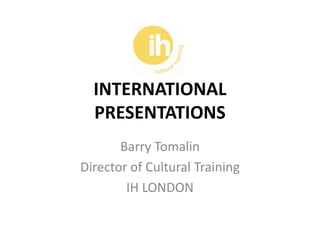
Presentations across cultures - How are they different?
- 1. INTERNATIONAL PRESENTATIONS Barry Tomalin Director of Cultural Training IH LONDON
- 2. INTERNATIONAL PRESENTATIONS POLL • Tell us now: - How often do you teach presentation skills & language? • Very often • Often • Not very often What are the main problems you face?
- 3. THE 7 POINTS • EXPECTATIONS What are audiences looking for? • DURATION How long do they expect to listen? • QUESTIONS Will they interrupt or ask questions? • STYLE Will they expect visuals, stories or demonstrations? • STRUCTURE How should I structure my presentation? • QUESTIONS AND INTERRUPTIONS How will I deal with questions? • FINISHING Should I expect applause at the end? If so what?
- 4. EXPECTATIONS • Entertainment • Action • Technical information • Hard sell – what’s in it for me? • Soft sell – features and benefits (I’ll make up my own mind.) • Intellectual argument • Make a good impression
- 5. DURATION • Short presentations 20- 30 minutes • Medium presentations 45 – 60 minutes • Long presentations 60 – 75 minutes plus
- 6. QUESTIONS • Questions at end • Interruptions in middle (often for clarification) • No questions • Deep concentration
- 7. STYLE • Who expects: - Talk? - Interaction? - Visuals ? - PPT’s? - Stories? ‘ a mixture of personal style and audience expectation.’
- 8. STRUCTURE ‘Tell them what you are going to say. Tell them you are saying it. Tell them you have said it.’ Sir Winston Churchill
- 9. STRUCTURE The three stages • Tell them what you will say SIGNPOST topic, time, key points, questions • Tell them you are saying it.. SIGNAL My next point is… That was my second point. My final point is. • Tell them you have said it. SUMMARISE summary, conclude, invite questions
- 10. QUESTIONS AND INTERRUPTIONS • THE FOUR ‘ASKS’ - Thank - Repeat - Answer - Check • F.A.C.E - Focus - Acknowledge - Clarify - Empathise
- 11. FINISH • Saying ‘Thank you.’ • Applause? • Silence? • Aggressive sounding questions – anger or interest? • Groups of people coming up afterwards – positive?
- 12. THANK YOU • Barry Tomalin • Director of Cultural Training • International House, London (E) barrytomalin@gmail.com (E) barry.tomalin@ihlondon.com (W) www.culture-training.com (W) www.ihlondon.com/executive- centre/cultural-training
- 13. THANKS Barry Tomalin (E) barrytomalin@gmail.com (E) barry.tomalin@ihlondon.com (W) www.culture-training.com • For the BUSINESS CULTURAL TRAINERS CERTIFICATE contact www.ihlondon.com/executive-centre/cultural- training
